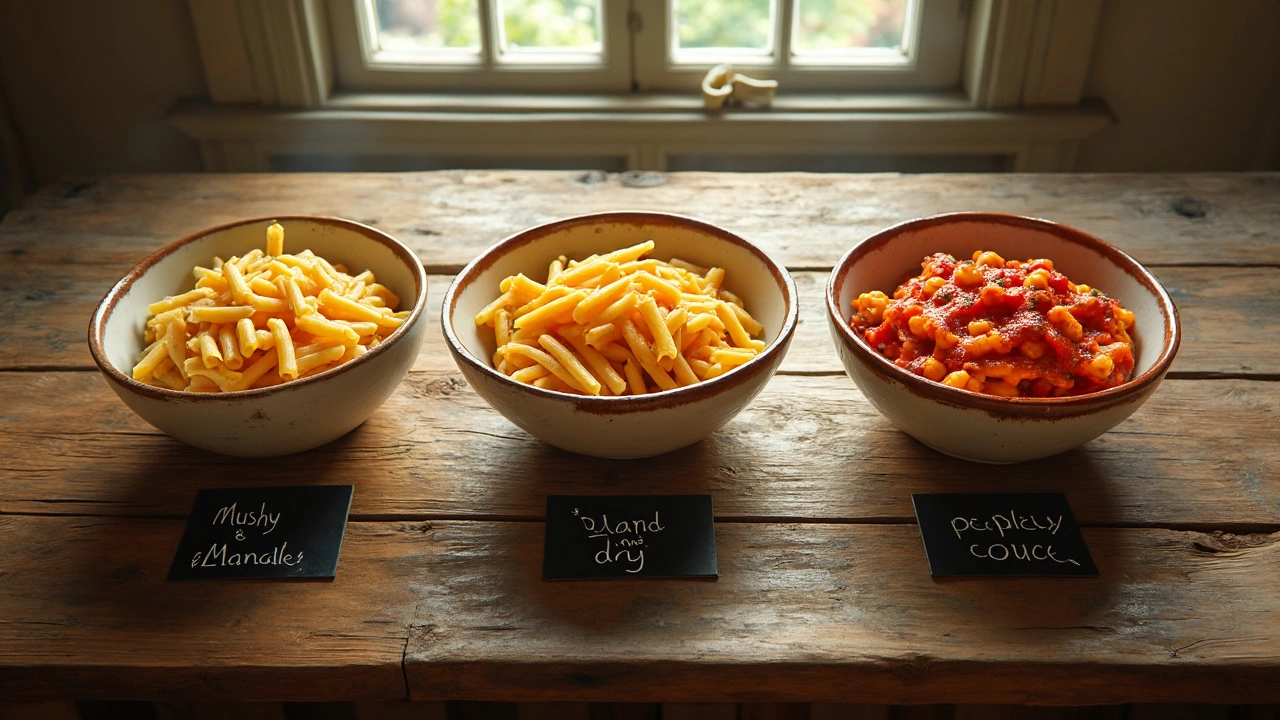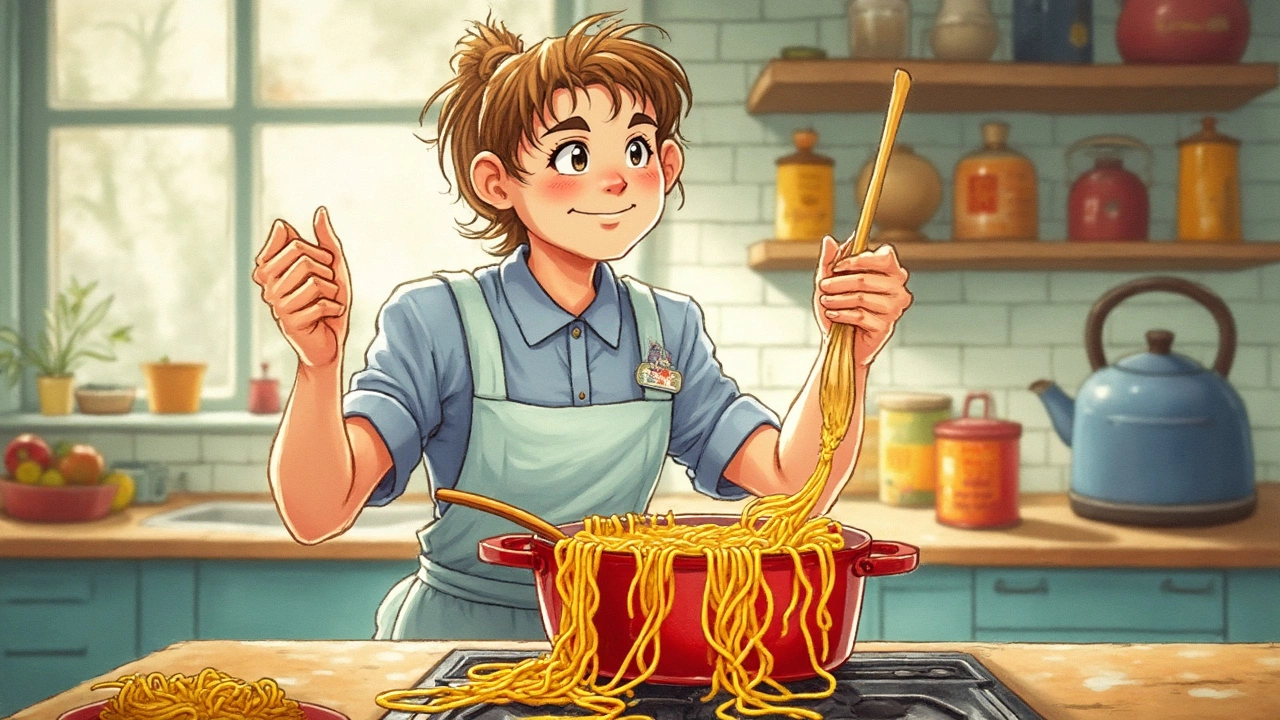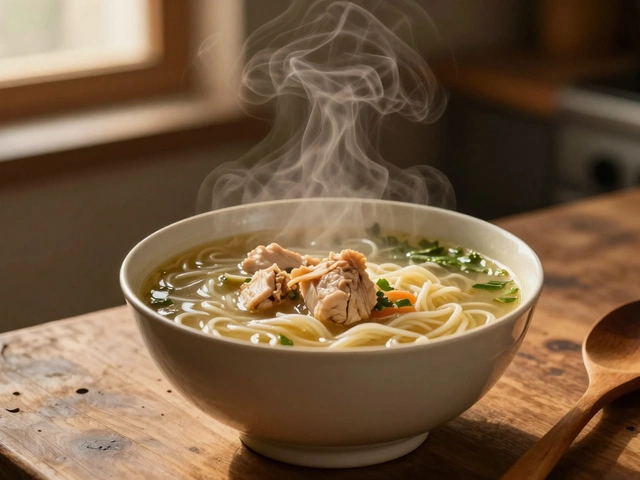Ever had pasta that clumped together, tasted flat, or just didn’t hit the spot? You’re not alone. Most pasta fails come down to a few easy-to-fix mistakes. Thing is, the little details—like how much water you use, when to add salt, or what you do after draining—can totally change the end result.
One of the classic blunders is using too small a pot. Pasta needs room to move, or it turns into a starchy blob. And if you skip the salt while boiling, your noodles will never taste good, no matter how much sauce you drown them in.
And hey, maybe someone told you to add oil to the water? Don’t do it. That trick just makes your pasta slippery, which means your sauce won’t stick. Next time you fire up the stove, keep these things in mind. There’s no magic—just a few habits to ditch, and a few new ones to pick up. Let’s get into the real do’s and don’ts so every noodle turns out like an Italian grandma made it.
- Starting Off on the Wrong Foot: Pot, Water, and Salt
- Oil in the Water? Nope
- Timing Trouble: Over- or Undercooking
- Rinsing Your Pasta—Just Don’t
- Sauce Sins: Adding Too Early, Too Late, or Too Little
- Finishing Touches: Things People Skip (But Shouldn't)
Starting Off on the Wrong Foot: Pot, Water, and Salt
Most pasta tragedies start before the noodles even hit the pot. Using a tiny pot? You're just asking for sticky pasta. When you drop dry noodles into too little water, the temperature drops fast and the water turns starchy. Give your pasta room to move so you don't end up with a gluey clump.
The golden rule: about 4-6 quarts of water per pound of pasta. That sounds like a lot, but it really makes a difference. Check this out:
| Pasta Amount | Water Needed |
|---|---|
| 1/2 lb (225g) | 2-3 quarts (2-3 liters) |
| 1 lb (450g) | 4-6 quarts (4-6 liters) |
Salt matters way more than you think. The old-school saying is, "the water should taste like the sea." Don't be afraid to throw in a handful—about 1-2 tablespoons per 4 quarts is a solid bet. This is the one big shot your pasta gets to soak up real flavor; sauce alone won't fix bland noodles.
Quick step-by-step:
- Pick a big pot. Use at least one that holds 6-8 quarts if you’re cooking for a few people.
- Fill with cold water to the right level (see the table above).
- Bring it to a proper, rolling boil before you even think about adding pasta. Throwing pasta into lukewarm water gives you mush, not magic.
- Slam in your salt only after the water is boiling. Salt can slow the boil a tiny bit, but it dissolves better in true boiling water.
Mess this part up and no fancy sauce will save you. Nail it and even simple spaghetti tastes like a pro cooked it. Pasta comes out perfectly when you start with the basics done right.
Oil in the Water? Nope
Everyone’s got that friend or relative who swears by pouring a glug of olive oil into the pasta water, promising it stops the noodles from sticking. Truth is, it’s one of the biggest myths in pasta cooking. A splash of oil does basically nothing for sticking, and it can actually mess things up.
The science is simple: oil floats on water and coats the pasta’s surface. That slick layer stops your sauce from clinging to the noodles later. So instead of soaking up all that tasty ragu or pesto, your pasta just slips around and tastes bland.
If you want to keep your pasta from sticking, here’s what actually works:
- Use a big pot with plenty of water (about 4-6 quarts per pound of pasta).
- Stir the pasta in the first couple minutes—it’s when noodles want to cling together.
Let’s look at what happens when you add oil versus when you skip it:
| With Oil in Water | Without Oil in Water |
|---|---|
| Pasta feels slippery, sauce slides off | Pasta holds sauce, flavors stick |
| Minimal effect on sticking during cooking | Pasta separates well if stirred early |
| Wastes good olive oil | No oil needed, saves money |
Food labs and pro chefs alike agree: leave the oil bottle on the counter. The stickiness issue almost always comes down to a lack of water, crowding the pot, or skipping the stir. Save your olive oil for dressing or finishing—not for the pot of boiling water.
Timing Trouble: Over- or Undercooking
When it comes to making great pasta, timing is everything. Undercooked noodles are chalky and tough, while overcooked pasta gets mushy and falls apart. The window for perfect doneness isn't as big as you might think.
That term you see on Italian restaurant menus—al dente—just means the pasta should be firm to the bite. Most boxed pasta brands (like Barilla or De Cecco) include a suggested cook time right on the package, but here’s the catch: Don’t trust it blindly. Start checking the noodles about 2 minutes before the earliest recommended time. Bite into a piece; if it's still got a tiny white core, let it go for another 30 seconds and check again.
If you rely only on the clock, you'll miss out on that perfect texture. Cooking conditions—anything from the shape of your noodles to how much water you’re using—change how fast the pasta cooks. For dishes where the pasta simmers longer in sauce, pull it out a little early since it'll pick up more doneness as it cooks with the sauce.
Here's a handy table comparing suggested cook times for popular pasta shapes if you're not sure where to start:
| Pasta Shape | Suggested Time (Minutes) |
|---|---|
| Spaghetti | 8-10 |
| Penne | 11-13 |
| Rotini | 8-10 |
| Fettuccine | 10-12 |
| Farfalle | 12-15 |
Some quick tips to get timing right every time:
- Set a timer, but taste at least twice before deciding your pasta's done.
- Don’t wander away; overcooking happens fast once you pass the sweet spot.
- If you’re finishing the pasta in sauce, drain it when it’s just shy of how you like it.
It's not fancy technique—just paying attention. Keep an eye on the clock, but trust your teeth more than your phone.

Rinsing Your Pasta—Just Don’t
If you’ve ever finished boiling pasta and reached for the cold water tap, you’re not alone. But here’s the deal: rinsing is one of the biggest mistakes you can make if you want tasty, sauce-hugging noodles. When you rinse pasta, you wash away all that starchy coating. That starch is gold—it’s what helps sauces stick and what gives pasta its ideal texture.
A lot of folks think rinsing gets rid of extra calories or "cleans" the pasta. Not true. If anything, you’re rinsing off the stuff that makes your pasta tasty and perfect for sauce. In Italian kitchens, you never see anyone rinsing noodles unless they’re cooking for a cold salad—where you actually want to stop the cooking and chill the pasta fast.
Let’s look at why rinsing doesn’t make sense for hot pasta dishes:
- Pasta needs that starchy layer for sauce to cling properly.
- Rinsing cools the noodles, making them less likely to absorb sauce flavor.
- You end up with slippery, bland pasta instead of a meal that holds together.
Here’s a quick comparison to show how rinsing stacks up:
| After Cooking | Rinsed Pasta | Non-Rinsed Pasta |
|---|---|---|
| Texture | Slippery, sauce slides off | Grippy, sauce sticks |
| Flavor | Bland, watery | Full, absorbs sauce |
| Best Use | Pasta salad, noodle stir-fries | Classic pasta with sauces |
The only time rinsing makes sense is when you’re prepping something cold, like a pasta salad, or when you need to stop the cooking right away, maybe for Asian noodle dishes. For everything else, just drain and go straight to the sauce. Your dishes will taste richer, and you’ll finally get why Italian cooks guard their starchy pasta water like it’s liquid treasure.
Sauce Sins: Adding Too Early, Too Late, or Too Little
This is where a lot of pasta dishes go from awesome to just…meh. Saucing pasta isn’t just dumping red stuff over noodles and calling it a day. Timing matters, and the amount matters even more. Mess this up, and you're probably not getting the most out of your dish.
Add sauce too early—while the pasta’s still cooking in the pot—and you’ll end up with overcooked, bland noodles. But wait too long, and the pasta cools down, the sauce slides off, and you miss out on that tasty magic that happens when it all comes together hot.
The sweet spot? Add the drained but still hot pasta directly into a pan with your simmering sauce. Don’t just toss it on top—let it finish together for about a minute. This move lets the noodles soak up the sauce, instead of just sitting under it. Italian chef Lidia Bastianich says,
“Always finish your pasta in the sauce for a minute or two so it absorbs the flavor. You want every bite to taste like it comes from one pot, not two.”
Now, don’t drown your noodles. Too much sauce turns pasta soupy, while too little leaves you hunting for flavor. Aim for just enough to lightly coat everything—no big pool left at the bottom of the bowl.
Here’s how different timing can affect your dish:
| Timing | Result |
|---|---|
| Add too early (to boiling water) | Sauce flavor gets lost, overcooked noodles |
| Add after draining, in hot pan | Pasta absorbs sauce, best flavor and texture |
| Add too late (to cold pasta) | Sauce won’t stick, pasta feels dry or greasy |
Bottom line: Don’t rush the sauce step, and don’t wait around either. Hit that timing sweet spot and your pasta tastes miles better. And remember—always finish both the pasta and sauce together, not separately.
Finishing Touches: Things People Skip (But Shouldn't)
After draining pasta, most people just dump some sauce and call it dinner. That’s where the real flavor gets lost. Want your pasta to go from good to "wait, did you really make this?" You have to nail the finishing steps.
First, always reserve a little pasta water before draining—about half a cup is enough. This is liquid gold when it comes to mixing your pasta and sauce. The starchy water helps the sauce cling to the noodles, turning everything silky instead of watery or clumpy.
"Pasta water is the secret ingredient that brings your sauce and pasta together. Chefs call it 'liquid gold' for a reason." — Lidia Bastianich, chef and cookbook author
Back in the pan, toss your cooked noodles with the sauce over medium heat for a minute or two. This last step cooks the sauce into the pasta and locks in that flavor. It seriously makes the difference between just eating pasta and eating something you'd want to show off.
After mixing, finish with a little drizzle of extra-virgin olive oil, a handful of chopped fresh herbs, or a dusting of cheese. Even adding just a squeeze of lemon brings everything to life. Skipping these makes your pasta feel flat, but they only take a few seconds.
- Pasta tip: A study from the Barilla Center for Food & Nutrition found that finishing pasta in the sauce improves overall satisfaction and flavor by up to 30%.
- Never forget to taste and adjust seasoning at the end—even the best sauce needs a last pinch of salt sometimes.
- If you’re saving leftovers, add a splash of pasta water when reheating to bring them back instead of letting them dry out.
| Finishing Step | Impact on Pasta |
|---|---|
| Adding reserved pasta water | Enhances texture, helps sauce stick |
| Finishing pasta in sauce | Better flavor absorption |
| Topping with herbs/oil/cheese | Adds aroma and extra flavor |
| Adjusting with salt/lemon | Brightens and balances taste |
The difference is in the details, and none of this takes chef-level skills—just a bit of extra care. Next time you’re boiling up noodles, don’t stop short. Those little touches at the end make anyone look like a pro.


